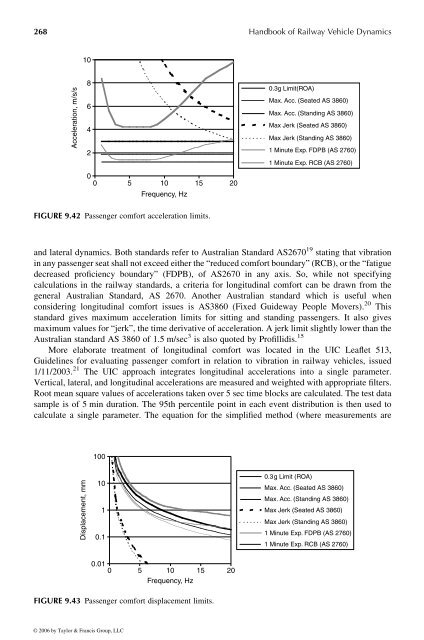Hi-Res PDF - CRCnetBASE
Hi-Res PDF - CRCnetBASE
Hi-Res PDF - CRCnetBASE
You also want an ePaper? Increase the reach of your titles
YUMPU automatically turns print PDFs into web optimized ePapers that Google loves.
268<br />
Acceleration, m/s/s<br />
and lateral dynamics. Both standards refer to Australian Standard AS2670 19 stating that vibration<br />
in any passenger seat shall not exceed either the “reduced comfort boundary” (RCB), or the “fatigue<br />
decreased proficiency boundary” (FDPB), of AS2670 in any axis. So, while not specifying<br />
calculations in the railway standards, acriteria for longitudinal comfort can be drawn from the<br />
general Australian Standard, AS 2670. Another Australian standard which is useful when<br />
considering longitudinal comfort issues is AS3860 (Fixed Guideway People Movers). 20 This<br />
standard gives maximum acceleration limits for sitting and standing passengers. It also gives<br />
maximum values for “jerk”, the time derivative of acceleration. Ajerk limitslightly lower than the<br />
Australian standard AS 3860 of 1.5 m/sec 3 is also quoted byProfillidis. 15<br />
More elaborate treatment of longitudinal comfort was located in the UIC Leaflet 513,<br />
Guidelines for evaluating passenger comfort in relation to vibration in railway vehicles, issued<br />
1/11/2003. 21 The UIC approach integrates longitudinal accelerations into asingle parameter.<br />
Vertical, lateral, and longitudinal accelerations are measured and weighted with appropriate filters.<br />
Rootmean square values of accelerations taken over 5sec time blocks are calculated. The testdata<br />
sample is of 5min duration. The 95th percentile point in each event distribution is then used to<br />
calculate asingle parameter. The equation for the simplified method (where measurements are<br />
Displacement, mm<br />
10<br />
8<br />
6<br />
4<br />
2<br />
0<br />
0 5 10 15 20<br />
100<br />
10<br />
1<br />
0.1<br />
0.01<br />
Frequency, Hz<br />
FIGURE 9.42 Passenger comfort acceleration limits.<br />
0 5 10 15 20<br />
Frequency, Hz<br />
FIGURE 9.43 Passenger comfort displacement limits.<br />
© 2006 by Taylor & Francis Group, LLC<br />
Handbook of Railway Vehicle Dynamics<br />
0.3g Limit(ROA)<br />
Max. Acc. (Seated AS 3860)<br />
Max. Acc. (Standing AS 3860)<br />
Max Jerk (Seated AS 3860)<br />
Max Jerk (Standing AS 3860)<br />
1Minute Exp.FDPB (AS 2760)<br />
1Minute Exp.RCB (AS 2760)<br />
0.3g Limit (ROA)<br />
Max. Acc. (Seated AS 3860)<br />
Max. Acc. (Standing AS 3860)<br />
Max Jerk (Seated AS 3860)<br />
Max Jerk (Standing AS 3860)<br />
1Minute Exp.FDPB (AS 2760)<br />
1Minute Exp.RCB (AS 2760)









